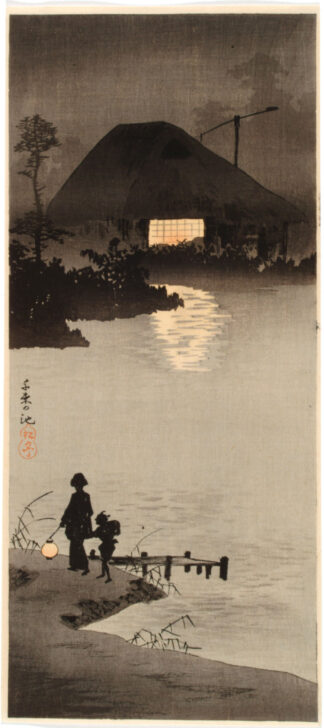Tematsu no ike (Tematsu Pond)
Takahashi Hiroaki

Description
Kawase Hasui and Takahashi Hiroaki both worked in concert with the prolific twentieth century publisher of woodblock prints Watanabe Shôzaburô (1885-1962). Their poetic and often times nostalgic landscape prints, very much following Edo period print master Andô Hiroshige’s foot prints (whose works are also shown in the gallery), have been highly sought after by collectors in Europe and North America.
Kawase Hasui was especially known for his skillful depiction of landscapes and night scenes. His passion for landscapes led him to travel extensively throughout Japan, keeping a sensitive eye on his surroundings and sketching scenes from his journeys. His close attention to atmospheric conditions and light brought him much success and one year before his death Kawase was awarded the great honor of Living Cultural Treasure for his 1956 print “Snow at Zôjôji Temple.”
Takahashi was trained in Japanese style painting (Nihonga), and dedicated much of his time to creating paintings for exhibitions as well as illustrations for scientific publications. While Kawase’s prints focus on notable places and landscapes, Takahashi’s work attempts to capture the essence of Japanese culture and everyday life.
(Japanese Gallery Rotation, Spring 2010)
(6/28/10)
*Gallery Rotation Winter 2011 (January 2011)
Takahashi Hiroaki
Japan, 1871–1944
Tematsu Pond
circa 1907–22
Meiji Period (1868–1912) to Taisho Period (1912–26)
Color woodblock print on paper
Museum purchase made possible by the Margaret Watson Parker Art Collection Fund, 2005/1.421
Subject Matter:
Takahashi Hiroaki worked with the prolific twentieth century publisher of woodblock prints Watanabe Shozaburo (1885-1962). Takahashi was trained in Nihonga, or Japanese painting, and dedicated much of his time to paintings for exhibitions and illustrations for scientific publications. His nostalgic “Old Japan” imagery was highly sought after by collectors in Europe and North America. Takahashi’s work attempts to capture the essence of cultural events and everyday life.
Physical Description:
In the lower left corner of this tall and narrow print two silohettes appear near a small dock. The surface of a pond stretches out behind them, filling much of the pictorial space. The dark form of a house with a traingular, mountain shapped roof rests in the upper register of the print. The lit windows from the house reflect in the calm yet slightly wavy pond.
Usage Rights:
If you are interested in using an image for a publication, please visit https://umma.umich.edu/request-image/ for more information and to fill out the online Image Rights and Reproductions Request Form.